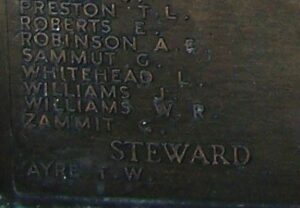The memory of the men and women of Ammanford who died in both World Wars is upheld by the pillars of the Memorial Park gates at Iscennen Road. One pillar holds the names of those that died in the Great War while the other holds the names of the men who died in the Second War, and one man who died in the Korean War. This page lists the men, along with the one woman, of Ammanford who gave their lives for freedom. There appears to be several men omitted from the war memorial for various reasons, so I have taken the liberty of including these below.
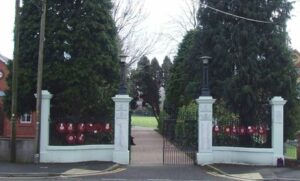
World War Two, 1939-1945
Ronald Llewellyn Anthony, Fusilier, 4209641, Royal Inniskilling Fusiliers. Ronald was born in 1922, the son of Willie David Anthony and Annie Mary Anthony (nee Davies), of Brookfield, 75, Parklands Road, Penybank, Ammanford. He enlisted into the army and was posted to the 6th Battalion, Royal Inniskilling Fusiliers. The battalion was converted from the 50th (Irish) Holding Battalion at Newtown, Montgomeryshire on 9 October 1940 and was stationed at various coastal areas around Wales, moving to Bangor and then to Trearddur Bay before joining the 38th Irish Infantry Brigade, of the 6th Armoured Division and sailed from the Clyde for the Middle East, landing in Algeria in November 1942, to join the North African Campaign. The 6th Armoured Division then took part in the latter stages of the campaign in Tunisia, which culminated in the surrender of the Axis Forces on 13 May 1943. Following a victory parade, the division then went into rest areas where it remained for the coming weeks. Ronald died in Tunisia on 19 July 1943, possibly from sickness. The 21-year-old was buried in a small cemetery, but the following month his remains were reinterred into Medjez-El-Bab War Cemetery, Tunisia.
Goronwy Amman Bassett, Flight Sergeant, 930637, Royal Air Force Volunteer Reserve. Goronwy was born in 1911, the son of Evan Bassett and Mary Bassett (nee Price) of Ddolyffin, Ammanford. He married Georgia Mary Chapman at Carmarthen in 1941. Goronwy enlisted into the Royal Air Force Volunteer Reserve and after completing his training as a Flight Engineer was posted to 644 Squadron, Royal Air Force, which was a heavy bomber unit, based at RAF Tarrant Rushton, in Dorset and was equipped with the Handley Page Halifax heavy bomber. He joined the crew Pilot Officer Alex Turnbull and successfully took part in ten bombing missions over occupied Europe by the time of their last flight. The crew took off from RAF Tarrant Rushton on the night of 23 April 1945, as part of a bomber force despatched to drop supplies to the Norwegian Resistance, as part of SOE Special Operation Crop 17. The Halifax successfully dropped its cargo and was on the return leg the following morning, 24 April 1945, when it was hit by German anti-aircraft fire and lost power from two of its four engines due to a fuel tank being holed. Without enough power, the stricken bomber crashed into Lake Mjosa in Norway, her entire crew, apart from one man, being killed on impact. Goronwy was 34 years old when he was killed that morning, and is commemorated on the Runnymede Memorial, Surrey. The remains of four of his fellow crewmen were recovered and buried at Lillehammer. The aeroplane was recovered from the lake in the 1980’s, and moved to Canada, where it has undergone a full restoration. It is now on display at the RCAF Museum at Trenton, Canada.
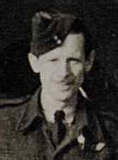
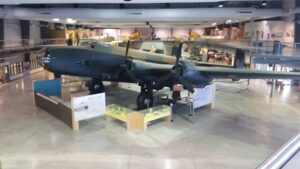
Annunziato Bonanno, Donkeyman, Merchant Navy. Annunziato was born in Malta in 1907, the son of Frank and Angela Bonanno. He came to live at Y Fron, Brynmawr Avenue, Ammanford prior to the outbreak of war, following several years living at Tower Hamlets, London. Annunziato was a sailor, serving with the Merchant Navy, and in 1943 was posted as a Donkeyman aboard the newly launched cargo steamer, SS Caleb Sprague. On 31 January 1944, Caleb Sprague was en-route from Newport, Mon to London, carrying a cargo of steel ingots and sheet material when she was attacked by a German E-Boat, southeast of Beachy Head, off the coast of Sussex, and was sunk by a torpedo which struck her stern. The steamer sank quickly, with the loss of twenty-five lives. Annunziato was 37 years old when he died that day and is commemorated on the Tower Hill Memorial, London. His widow, Ivy, later married Ernald Vincent Evans, of Ammanford and the couple moved to London. Annunziato is not commemorated on the Ammanford War Memorial.

John Ernest Branchett, Private, 5379784, Oxford and Bucks Light Infantry. John was born on 21 June 1910, the son of William Charles Abraham Branchett and Emma Branchett (nee Gibbs), of 45, Station Road, Tirydail, Ammanford. His father, a colliery engineman, served during WW1 and later moved the family away to Reading, Berkshire. John enlisted into the army some years prior to the outbreak of WW2, and served on the North-West Frontier of India with the 2nd Battalion, Oxford & Bucks Light Infantry. Upon his return to England following the outbreak of war he married Florence Gleghorn at Reading, but was soon posted to France with the BEF, becoming attached to the Royal Engineers. Little else is currently known of John, but he was posted as missing on 9 June 1940, following the evacuation from Dunkirk and the other French coastal ports and was later posted as being presumed as killed in action on that date. The 29-year-old has no known grave, so is commemorated on the Dunkirk Memorial, France. John is not commemorated on the Ammanford War Memorial.
George Cooke, Sergeant, 13062396, Pioneer Corps. George was born on 17 August 1910, the son of George Cooke and Hannah Cooke (nee Fletcher), of 4, Frederick Street, Salford. He worked as a timber yard labourer prior to enlisting into the army and was posted to the Pioneer Corps. He was based in South Wales when he married Elizabeth Loraine Thomas, of Ammanford, in 1942, prior to embarking for North Africa. George then took part in the North African Campaign, until the surrender of the Axis Forces there on 13 May 1943. Attention then switched to the invasion and liberation of Italy, the first phase of this being the landings on Sicily, Operation Husky, which began on 9 July 1943. George was posted as missing, believed killed at Sicily on 21 July 1943, but was later confirmed to have been accidentally killed on that date, together with three other comrades. The 36-year-old was buried besides his three comrades in Beja War Cemetery, Tunisia. George is not on the Ammanford Memorial, but is commemorated on the new memorial at Cwmamman.
Benjamin Davies, Gunner, 11408707, Royal Artillery. Benjamin was born on 11 April 1919, the son of John Ebenezer Davies and Gwenllian Davies (nee Bevan), of 3, Cooper Well, Pantyffynnon. He enlisted into the Royal Artillery and trained as a Maritime Gunner before being posted to the 4/2 Maritime Regiment, Royal Artillery. He was then posted as an Anti-Aircraft Gunner aboard the S.S. Ocean Honour, a Liberty Ship, which had been built in California and delivered to the Merchant Navy in May 1942. On 16 September 1942, Ocean Honour was in the Gulf of Aden, carrying a cargo of 6,000 tonnes of government stores and motor vehicles, when she was torpedoed by the Japanese Submarine I-29. She sank almost immediately, but 29 of the crew managed to escape the sinking. Benjamin was one of the 20 men who died aboard the ship that day. The 23-year-old has no known grave, so is commemorated on the Portsmouth Naval Memorial, Hampshire.
Brinley Davies, Craftsman, 7643871, Royal Electrical and Mechanical Engineers. Brinley was born on 4 March 1915, the son of Anthony Davies and Catherine Davies (nee Thomas), of 59, Penybank Road, Ammanford. He married Glenys Williams in 1938 and the couple settled at 43, Villiers Road, Ammanford where their son Brian was born in 1940. Brinley worked as a colliery labourer prior to enlisting into the Royal Electrical and Mechanical Engineers and was posted to the Dutch East Indies. He was unfortunately one of the many British Servicemen to be captured by the Japanese after their invasion of Malaya, after initially being reported as missing in the Dutch East Indies on 1 February 1942, and was taken to a POW Camp. Brinley survived just nine months in captivity, as he died of sickness aboard the Japanese ‘Hell-Ship’, Singapore Maru in Moji Harbour on 24 November 1942. Brinley had been given the POW Number 645, and was buried at Moji Communal Grave, but is now commemorated on the Yokohama Cremation Memorial, Japan.
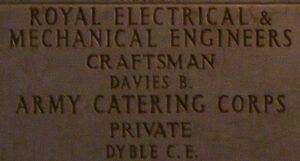
D. Douglas Davies, Flying Officer, Royal Air Force. This man cannot presently be identified. He is commemorated both on the Ammanford War Memorial Gates and at Bethany Baptist Chapel, however no man of that name fell during the Second World War.
Ronald James Davies, Able Seaman, D/JX 165549, Royal Navy. Ronald was born on 17 November 1918, the son of Harold Davies and Miriam Davies, of 17, Coronation Terrace, Betws, Ammanford. He had been working as a Roadstone Slate Quarrier prior to enlisting into the Royal Navy soon after the outbreak of war and upon completing his training was posted aboard the Town-class light cruiser, HMS Gloucester. When war broke out, Gloucester was flagship of the 4th Cruiser Squadron, serving in the East Indies and spent the rest of that year patrolling the Indian Ocean. In December, she was moved to Simonstown, South Africa where she was used, unsuccessfully, against German raiders. She was transferred again in May 1940, to the Mediterranean, where she experienced plenty of action, being involved in the Malta convoys and the Battle of Calabria on 9 July 1940. An Italian air attack on 8 July had hit the ship’s bridge killing or wounding most of the bridge personnel, including the Captain, F R Garside. The second half of 1940 was spent in the eastern Mediterranean and in the Aegean. On 11 January 1941, while supporting Operation Excess, Gloucester was hit by a bomb which failed to explode. In March, she was at the Battle of Matapan and, in April, performed several bombardments along the North African coast. A second bomb hit caused minor damage. Gloucester formed part of a naval force acting against German military transports to Crete, with some success. On 22 May 1941, while in the Kithera Channel, about 14 miles north of Crete, she was attacked by German Stuka dive bombers and sank, having sustained at least four heavy bomb hits and three near-misses. 723 lives were lost, with just 82 survivors. Her sinking is considered to be one of Britain’s worst wartime naval disasters. Ronald was just 21 years old when he was killed during the loss of Gloucester that day. He has no known grave, so is commemorated on the Plymouth Naval Memorial, Devon.
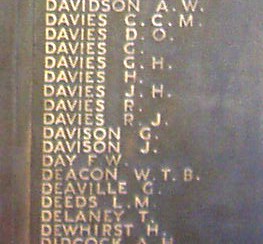
Roy Davies, Naval Airman 2nd Class, FAA/FX. 78100, Royal Navy. Roy was born in Clapham, London on 23 June 1919, the son of Joseph Davies and Mary Davies. His mother died when he was young and his father returned to Wales, settling at Woodway, Tycroes, Ammanford. Roy worked as a solicitor’s clerk prior to enlisting into the Royal Navy, and upon completing his training was posted to HMS Goshawk, which was the Royal Naval Air Station at Trinidad, used for fighter training. On 15 January 1941, Roy embarked at Liverpool aboard the ocean liner SS Almeda Star. The ship sailed later that day, bound for the River Plate, carrying 194 passengers including 142 members of the Fleet Air Arm en route to Trinidad. The ship steamed out of Liverpool through the Western Approaches into an area of sea being patrolled by German submarines. At 7.45 on 17 January 1941, Almeda Star was about 35 nautical miles north of Rockall when the German submarine U-96 fired a single torpedo at her, striking her amidships, and caused Almeda Star to stop. The Germans struck her with two more torpedoes then surfaced and attacked the ship with her deck gun, before finishing her off with a fourth torpedo, which sent her to the bottom of the sea. All 360 people aboard were lost, including those in the four lifeboats that had been launched. Roy was just 21 years old when he died that day and is commemorated on the Lee-on-Solent Memorial, Hampshire. Roy is not commemorated on the Ammanford War Memorial.
Thomas John Davies, Sailor, Merchant Navy. Thomas was born in 1922, the son of Annie Davies (nee Thomas), of 7, Bungalows, Newtown, Ammanford. He enlisted into the Merchant Navy and was posted aboard the Sunderland registered cargo steamer SS Brinkburn. Early in June 1943, Brinkburn left Swansea for Philippeville, carrying a cargo of 2500 tons of government stores, including 800 tons of ammunition, attached to Convoy TE-22. The ship steamed past Gibraltar on 18 June and entered the Mediterranean. Three days later, on 21 June 1943 Brinkburn was off Algiers when she was torpedoed and sunk by the German submarine U-73, going down with the loss of 26 lives. Thomas was 20 years old when he died that day and is commemorated on the Tower Hill Memorial, London.
Thomas Luther Davies, Greaser, Merchant Navy. Thomas was born on 14 November 1907, the son of David Walter Davies and Annie Davies (nee Evans), of 4, Wern Terrace, Betws, Ammanford. He enlisted into the Merchant Navy soon after the outbreak of war and was posted as a Greaser aboard the London registered oil tanker MV San Emiliano. On 19 July 1942, San Emiliano left Curaçao with a cargo of aviation fuel, bound for Suez via Trinidad. She passed Trinidad on 6 August heading in the direction of Table Bay. Three days later, on 9 August 1942, San Emiliano was some 450 miles off Trinidad when she was torpedoed and sunk by the German submarine U-155, going down with the loss of 39 lives. Thomas was 35 years old when he died that day and is commemorated on the Tower Hill Memorial, London.
Winston Davies, Ordinary Artificer 3rd Class, D/MX 64084, Royal Navy. Winston was born on 18 April 1918, the son of Edward Davies and Martha Davies (nee Anthony), of 35, Tirydail Lane, Ammanford. He worked as a colliery fitter prior to enlisting into the Royal Navy and after completing his training was posted aboard the Admiralty class destroyer HMS Warwick. Warwick had seen service during the latter stages of the Great War and continued to serve throughout the inter-war period, although due to her age was transferred to anti-submarine and convoy escort duties. In mid 1943 she was converted to a long range escort ship, receiving extra fuel tanks and depth charge launchers, as well as a modern radar installation, before resuming duties. She then saw much service in the Bay of Biscay, before being refitted over the winter of 1943-44. In January 1944 Warwick was assigned to lead an escort group operating in the Southwest Approaches, guarding against attacks by German S-boats and submarines. On 19 February 1944, Warwick and the destroyer Scimitar were ordered from Devonport to hunt a submarine that had been reported near Trevose Head, Cornwall. On 20 February 1944, Warwick was hit on the stern by a torpedo fired by the German submarine U-413, and sank in minutes, with the loss of 67 lives. Winston was 25 years old when he was killed in the loss of Warwick. He has no known grave so is commemorated on the Plymouth Naval Memorial, Devon.
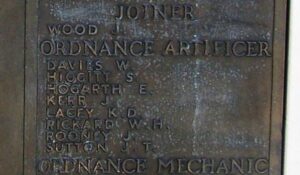
Edwin Lewis Eden, Able Seaman, D/JX287336, Royal Navy. Edwin was born in Llanelli on 9 November 1921, the son of George Henry Eden and Agnes Myfanwy Eden (nee Lewis). His father was a train driver for the GWR and later moved the family to 1d, New Road, Ammanford. Edwin enlisted into the Royal Navy soon after the outbreak of war and was eventually posted to HMS Copra, the Combined Operations Pay, Ratings and Accounts establishment which had been set up to process the pay and allowances of Royal Navy personnel serving in Combined Operations in WW2. Edwin was one of a handful of personnel from Copra to have landed at Normandy as part of the Combined Operations forces in June 1944. He was sadly killed in Normandy on 21 June 1944, aged just 22. Edwin was originally buried near Calvados, but in January 1945 his grave was exhumed and he was re-interred in Bayeux War Cemetery.
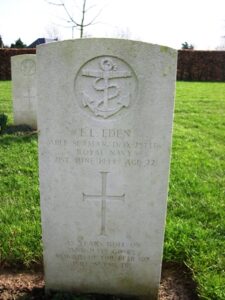
Daniel Isaac Evans, Private, 3960739, North Staffordshire Regiment. Daniel was born in 1917, the son of David Evans and Annie Evans (nee Bowen), of 49, Wind Street, Ammanford. He married Emily Lucy Sunderland, of Saron, in 1938. Daniel enlisted into the army and was posted to the 2nd Battalion, North Staffordshire Regiment. The battalion was in France with the BEF when war erupted, as part of the 2nd Infantry Brigade, 1st Infantry Division and was evacuated from Dunkirk on 1 June 1940. The battalion then spent almost three years on home defence until 1943 when it sailed with the remainder of the 1st Infantry Division for North Africa, to take part in the campaign in Tunisia as part of the First Army. By now the Axis forces defeated at El Alamein were withdrawing into Tunisia along the coast through Libya, pursued by the Allied Eighth Army. By mid April 1943, the combined Axis force was hemmed into a small corner of north-eastern Tunisia and the Allies were grouped for their final offensive. Daniel was killed around this time, on 29 April 1943, at the height of Operation Vulcan. The 26-year-old was buried on the battlefield as an Unknown Soldier. His grave was exhumed, together with other battlefield burials, in March 1944 and identified before being re-interred in Massicault War Cemetery, Tunisia.
J. L. Evans. This man cannot presently be identified.
Kenneth Evan John Evans, Flight Sergeant, 1018216, Royal Air Force Volunteer Reserve. Kenneth was born at Goodwick, Pembrokeshire on 24 February 1920, the son of Emlyn Evans and Martha Evans (nee Davies). The family moved back to Llanelli soon afterwards. Kenneth had worked for the Western Welsh Omnibus Company at Ammanford and at Haverfordwest prior to the war. He then enlisted into the Royal Air Force Volunteer Reserve and after completing his training was posted to 104 Squadron, Royal Air Force, which was equipped with the Vickers Wellington II, and was based at RAF Kabrit, in Egypt. By the time Kenneth joined the squadron it was employed on attacking targets in Italy, flying from Kabrit. On 24 February 1942, Kenneth took off from Kabrit aboard a Vickers Wellington II, Serial W5422 on a raid on landing grounds at Berka, Libya. He was posted as missing, believed killed, when his aircraft failed to return that day. The 22-year-old has no known grave and is commemorated on the Alamein Memorial, Egypt. Kenneth is not commemorated on the Ammanford War Memorial.
Thomas Lyn Evans, Flight Sergeant, 1321223, Royal Air Force Volunteer Reserve. Thomas was born at Llanwnda, Pembrokeshire on 26 December 1913, the son of David Thomas Evans and Mary Hannah Evans (nee Owen). The family moved to Ammanford soon afterwards. Thomas was drawn back to his birthplace as a young man, taking up a post as Chief Port Officer at Fishguard and lodged at 36, Plas-Y-Gamil Road. He then left his position to enlist into the Royal Air Force Volunteer Reserve, training as a Navigator before being posted to 158 Squadron, Royal Air Force. The squadron was a bomber squadron, which had been re-formed in 1942 and attached to No. 4 Group of Bomber Command. It was originally equipped with the Vickers Wellington, but later that year changed to the Halifax Heavy Bomber, based at RAF Lissett. On the night of 20 December 1943 Thomas and his fellow crewmen took off from Lissett in Halifax II, Serial JD115, as part of a 650 bomber raid on Frankfurt. Unfortunately the aircraft was shot down and crashed at Kraftsolms, six Miles Southeast of Braunfels, with the loss of all but one of its crew of seven men. Thomas was 29 years old when he was killed in the crash that night and was buried besides the remains of his fellow crewmen in Kraftsolms Civil Cemetery. In May 1947 the mens graves were exhumed and they were re-interred in Hanover War Cemetery, Germany. Thomas is not commemorated on the Ammanford War Memorial.
William Myrddin Evans, Sergeant, 929623, Royal Air Force Volunteer Reserve. William was born at Merthyr Tydfil on 13 October 1912, the son of James Evans and Emily Evans (nee Price). He married Brenda Williams at Ammanford in 1941. William worked as a Clerk at Ammanford prior to enlisting into the Royal Air Force Volunteer Reserve and trained as a Wireless Operator/Air Gunner before being posted to 115 Squadron, Royal Air Force. The Squadron was based at RAF Marham, in Norfolk and was equipped with the Vickers Wellington Bomber. The squadron undertook a number of raids against the Channel Ports in occupied Norway and France throughout 1940 and 1941. On 24 November 1941 William took off from RAF Marham aboard Wellington IC, Serial Z8863, for a low flying exercise. The aircraft collided with a row of railway trucks on the March to Spalding line, crashed and exploded, with the loss of six crew and three ground crew who were also aboard. William’s remains were transported back to Ammanford, and the 29-year-old was buried with full military honours in Ammanford (Bethany) Calvinistic Methodist Chapelyard.
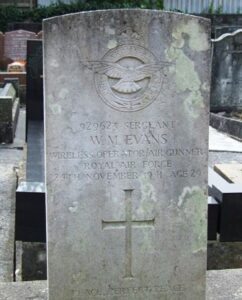
William Alfred Farley, Leading Aircraftman, 1409468, Royal Air Force Volunteer Reserve. William was born at Swansea in 1921, the son of Jack Farley and Edith Florence Farley (nee Saunders). The family later came to reside at Mount View, Saron, Ammanford. William enlisted into the Royal Air Force Volunteer Reserve and was posted to RAF Limavady, Co. Londonderry, Northern Ireland. He married Barbara Leslie Lomax whilst on leave in Surrey in 1944. William had almost survived the war in Europe, but took ill whilst back at RAF Limavaldy and on 12 April 1945 was admitted to the Royal Naval Auxiliary Hospital, Londonderry, where he died of a sub arachnoid haemorrhage on 23 April 1945. The remains of the 23-year-old were brought home and he was buried in Ammanford Cemetery. William is not commemorated on the Ammanford War Memorial.
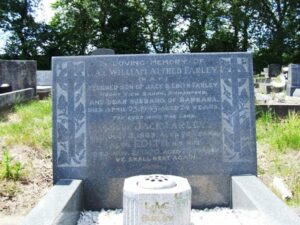
David Meirion Fowler, Marine, PLY/X113039 (D), Royal Marines. David was born on 27 March 1925, the son of David James Fowler and Susie Fowler (nee Morgan), of Brynhyfryd, Bettws. He enlisted into the Royal Marines, and trained at Plymouth before being posted overseas, to HMS Golden Hind, the Royal Naval Shore Establishment at Sydney, Australia. There was a large contingent of Royal Marines stationed at Sydney, to enable immediate replacement of casualties aboard the Royal Naval ships serving in the Pacific. David died whilst flying aboard a Dakota IV, Serial KN530, which was shot down by Japanese aircraft and crashed into San Pedro Bay, Samar Island, Philippines on 24 July 1945, with the loss of ten lives. The location is in the northern section of the infamous Leyte Gulf. David was 20 years old and was originally buried in the USAF Cemetery at Leyte. In October 1947 his grave was exhumed and he was re-interred in Sai Wan War Cemetery, Hong Kong. The Cemetery contains the graves of mostly ex-POW’s.
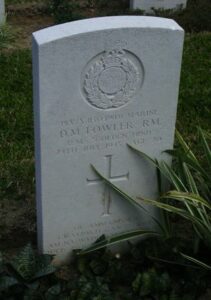
David Richard George, Rifleman, 6896152, King’s Royal Rifle Corps. David was born in 1915, the son of William George and Mary Ann George (nee James), of 27, Bishops Road, Ammanford. He enlisted into the army prior to the war and served with the 1st Battalion, (The Rangers), King’s Royal Rifle Corps. The Battalion was attached to the 30th Infantry Brigade, and was in Northern France, as part of the BEF in 1939. David must have been taken ill and returned home for treatment, as he died at Brigg Military Hospital, Yorkshire on 9 April 1940. The remains of the 25-year-old were brought home and he was buried in Ammanford Cemetery.
Bertram Howard Harries, Corporal, 4205049, Royal Corps of Signals. Bert was born on 13 January 1915, the son of Hendry Harries and Rachel Ann Harries (nee Williams), of Arosfa House, Ammanford. He married Sarah Winnie Carrod, of Llandebie, in the summer of 1939 before enlisting into the army. Bert then served with the Royal Corps of Signals, and was posted to Burma, where he became attached to the 7th Indian Division Signals. The division had been formed in October 1940, under British command, initially training for operations in the Middle East, but with the surrender of the Axis Forces there in May 1943 was reassigned to Burma. After extensive retraining the Division took part in an offensive in Arakan, the coastal province of Burma from December 1943 onwards, advancing down the Kalapanzin River valley as part of XV Corps. In February 1944, Japanese troops broke through the division’s front and horrific fighting ensued. Bert was posted as missing, believed killed in action in Burma on 6 February 1944, at the height of the fighting. The 29-year-old has no known grave, so is commemorated on the Rangoon Memorial, Myanmar.
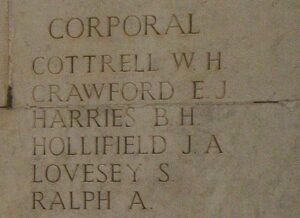
Hughie Hughes, Guardsman, 2735195, Welsh Guards. Hughie was born in 1917, the son of Hugh Hughes and Harriet Hughes (nee Walters), of Ammanford. He enlisted into the army and was posted to the 3rd Battalion, Welsh Guards. The battalion formed at Beavers Camp, Hounslow on 24 October 1941 and embarked for North Africa on 5 February 1943, landing in Algiers eleven days later. The battalion entrained to El Aroussa, twenty miles south of Medjez El Bab, where it joined the 1st Independent Infantry Brigade (Guards) on 1 March. The battalion saw its first action during the capture of the Fondouk Gap which helped push the Afrika Korps into full retreat. The battalions next action occurred on 8 May, when it supported the attack of the 6th Armoured Division upon the town of Hammam Lif. The attack was successful, but Hughie was among 24 men killed and 50 wounded from the battalion during the day. The 26-year-old was originally buried in a small battlefield cemetery, but early in 1944 the graves were all exhumed and moved into Enfidaville War Cemetery, Tunisia. He is also commemorated on the Llanddarog war memorial.
William John James, Donkeyman, Merchant Navy. William was born on 14 May 1892, the son of William John James and Sarah James, of Skewen. He married Amy Ivy Vanstone, of Neath, in 1920 and by 1924 the couple were residing at Haverfordwest where their son William was born. William was a long serving seaman, serving with the Merchant Navy, and by the time war erupted Amy had moved with the family to Ammanford. Two years after the outbreak of war, William, a Donkeyman and Greaser, was posted aboard the London registered steamer SS Empire Wagtail. Empire Wagtail was built in 1919, as American Ossining for the US Shipping Board, Tacoma. In 1933 she was renamed Point Lobos for the Gulf Pacific Mail Line, San Francisco, and in 1941 given to Britain, and renamed Empire Wagtail by the Ministry of War Transport. In December 1945, Empire Wagtail left Cardiff laden with a cargo of coal and joined up with Convoy ONS 154, bound for Halifax, Nova Scotia. The Convoy had left Britain on 19 December and comprised of 45 Merchant ships, escorted by five corvettes of the Royal Canadian Navy, a rescue ship, and a refuelling tanker. On 28 December 1942, when about 900 miles west of Cape Finisterre, Empire Wagtail was torpedoed by the German submarine U-260 and sank with the loss of her master, 31 crew members and seven DEMS gunners. William was 50 years old when he was killed that day and is commemorated on the Tower Hill Memorial, London. William is not commemorated on the Ammanford War Memorial.
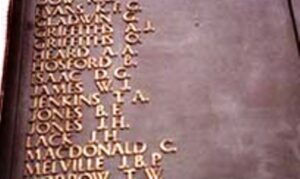
David Rees Douglas Jenkins, Private, 14201507, Gordon Highlanders. David was born in 1922, the son of Thomas Jenkins and Sarah Ann Jenkins (nee Thomas), of 17, Mill Terrace, Pantyffynnon. He enlisted into the army and was posted to the 1st Battalion, (The London Scottish), Gordon Highlanders. The battalion was a Territorial Army unit from London, attached to the 168th (London) Infantry Brigade, 56th (London) Infantry Division. Upon mobilisation, the division was placed on home defence duties in Kent, before embarking for the Middle East on 25 August 1942, joining the 5th Infantry Division in III Corps, under the Persia and Iraq Command. The Division remained in Persia for seven months and had just received orders to prepare for a move to Egypt when David was killed in an accident on 3 March 1943. The 21-year-old was originally buried at Kirkuk, but in August 1944 the war graves there were exhumed and re-interred in Mosul War Cemetery, Iraq.
Thomas Jennings, Assistant Steward, Merchant Navy. Thomas was born in Liverpool on 28 November 1902, the son of Edmund Jennings and Jane Jennings (nee Ward). He married Annie Collins at Liverpool in 1927 and the couple had three children during the coming years. Thomas was a seaman and was already serving with the Merchant Navy by the time war erupted. By then Annie had moved with her three children to Betws, Ammanford. Thomas was posted aboard the Liverpool registered MV Apapa, which had been built by Harland and Wolf in Belfast in 1927 for the Elder Dempster Line. Soon after the outbreak of war, Apapa sailed together with her sister ship Accra from Liverpool to West Africa, where she picked up some 95 passengers and a cargo of gold bullion. On 15 November 1940, on her return journey, Apapa was attacked and bomber by German FW 200 Condor aircraft some 200 miles off Achill Head, County Mayo and sank with the loss of some 27 lives. Thomas was 38 years old when he was killed that day. He has no known grave, so is commemorated on the Tower Hill Memorial, London. Thomas is not commemorated on the Ammanford War Memorial.

Cyril James Jones, Able Seaman, D/JX 314410, Royal Navy. Cyril was born on 25 May 1915, the son of James Haydn Jones and Mary Elizabeth Jones (nee Walters), of 4, Harold Street, Ammanford. He worked as a collier prior to enlisting into the Royal Navy and was posted to HMS President III for training. Upon completing his training, Cyril was posted aboard the Bideford registered MV Cornish City, which had been built at Middlesborough as a collier for the Reardon Smith Line of Cardiff in 1936. In July 1943, Cornish City departed from Lourenço Marques carrying a cargo of 9,600 tonnes of coal, reaching Durban on 22 July, before steaming towards Aden for the Suez Canal. On 29 July 1943 Cornish City was southeast of Madagascar, en-route for Aden, when she was torpedoed and sunk by the German submarine U-177, sinking with the loss of 37 lives. Cyril was 28 years old when he was killed that day. He has no known grave, so is commemorated on the Tower Hill Memorial, London.
Edgar Jones, Private, 13087060, Pioneer Corps. Edgar was born in about 1911, the son of Tom Jones and Mary Jones (nee Rees), of Ammanford. He married Phoebe Hitchcock, of Derby, in 1939. Edgar enlisted into the army and was posted to the Pioneer Corps. Very little else is known of Edgar, but he most probably served in North Africa with the Pioneer Corps, before taking part in the Allied invasion of Italy. He died in Italy on 22 March 1945, aged 33. is buried in Montecchio War Cemetery, Italy.
Glyn Aneurin Jones, Stoker 1st Class, D/KX 88239, Royal Navy. Glyn was born on 17 April 1917, the son of David Idris Jones and Margaret Jane Jones (nee Williams), of 8, Coronation Terrace, Bon Llwyn, Ammanford. He enlisted into the Royal Navy and upon completing his training was posted aboard the Town-class light cruiser HMS Gloucester. When war broke out, Gloucester was flagship of the 4th Cruiser Squadron, serving in the East Indies, and spent the rest of that year patrolling the Indian Ocean. In December, she was moved to Simonstown, South Africa where she was used, unsuccessfully, against German raiders. She was transferred again in May 1940, this time to the Mediterranean, where she experienced plenty of action, being involved in the Malta convoys and in the Battle of Calabria on 9 July 1940. She was damaged during an Italian air attack on 8 July, but after repairs returned to duty in the Mediterranean and in the Aegean. On 11 January 1941, while supporting Operation Excess, Gloucester was hit by a bomb which failed to explode. In March, she took part in the Battle of Matapan and in April carried out bombardments along the North African coast. Gloucester then formed part of a naval force acting against German military transports to Crete, following the German airborne invasion of the island which began on 20 May. On 22 May 1941, while in the Kithera Channel, about 14 miles north of Crete, she was attacked by German Stuka dive bombers and sank, with some 723 lives lost, and just 82 survivors. Glyn was 24 years old when he was killed that day. He has no known grave, so is commemorated on the Plymouth Naval Memorial, Devon. Glyn is not commemorated on the Ammanford Memorial, but at Llandebie.
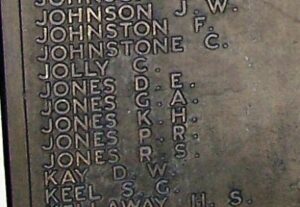
Luther John Jones, Sergeant, 1669239, Royal Air Force Volunteer Reserve. Luther was born on 8 August 1924, the son of Griffith John Jones and Hannah Jones (nee Howells), of 1, Hall Street, Ammanford. Luther enlisted into the Royal Air Force Volunteer Reserve and after completing his training as a Wireless Operator/ Air Gunner was posted to 51 Squadron, Royal Air Force, which was a heavy bomber unit, based at RAF Snaith, in Yorkshire. The Squadron had flown its first operational missions of the Second World War on the very first night of the War, 3 – 4 September 1939, dropping leaflets over Germany. Bombing missions started in May 1940, and continued until 1942 when No 51 was assigned to anti-submarine patrols over the Bay of Biscay as part of Coastal Command. The following year, the squadron re-equipped with the Handley Page Halifax and the unit returned to Bomber Command for the remainder of the war. On the night of 23 September 1944, Luther and his crew took off in their Halifax III, Serial MZ972, as part of a raid on Calais, to bomb an enemy strong point, as part of a large flight of 188 bombers. The raid was a success, but Luther’s Halifax was shot down on the the following morning of 24 September 1944, killing all of the crew of seven. Luther was only 20 years old when he was killed that morning. He was originally buried in a communal grave, together with his six fellow crewmen, at Oyes, France, but early in 1947 the grave was exhumed and the men were re-interred in a collective grave in Pihen-Les-Guines War Cemetery, France.
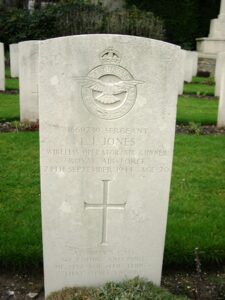
Thomas John Jones, Private, 14205100, South Lancashire Regiment. Thomas was born on 20 September 1922, the son of David William Jones and Margaret Ann Jones (nee Williams), of 10, Llandybie Road, Tirydail, Ammanford. He worked as a coal hewer prior to enlisting into the army and was posted to the 1st Battalion, South Lancashire Regiment. The battalion had been in France with the BEF at the outbreak of war, attached to the 12th Infantry Brigade, 4th Infantry Division and was evacuated from Dunkirk. After returning to Britain the battalion was transferred to the 8th Infantry Brigade, 3rd Infantry Division. The division remained in Britain for the next few years, before landing on the Normandy beaches as part of the first wave on D-Day, 6 June 1944, with the 1st South Lancs coming ashore on Queen White Beach at 7.20 am, before fighting through the German defences toward Hermanville, which was captured soon after. Over the coming days the battalion captured the villages of Plumetot, Cresserons and La Deliverande, as well as securing the famous Pegasus Bridge across the Orne River. The battalion was then heavily involved during the bloody fighting for Caen, suffering heavy casualties around Le Londel. Thomas was killed in action here, just 3 weeks into the Normandy battles, on 27 June 1944. The 21-year-old has no known grave and is commemorated on the Bayeux Memorial, France.
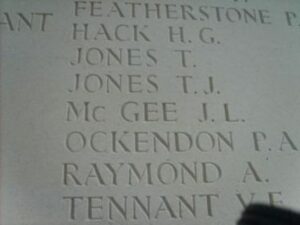
Trevor Lewin Jones, Leading Stoker, D/KX85153, Royal Navy. Trevor was born on 18 June 1913, the son of William Henry Jones and Clara Elizabeth Jones (nee Lewis), of 37, Maesyquarre Road, Betws, Ammanford. His mother died when he was just three and his father remarried Amelia Ann Wilson in 1921. Trevor enlisted into the Royal Navy, and upon completing his training was posted aboard the aircraft carrier HMS Illustrious. Illustrious joined the Mediterranean Fleet in August 1940, and was used to provide convoy cover, perform anti-shipping strikes, and also to raid Italian and German positions in North Africa. On 31 August 1940 she was used to launch a strike against airfields at Maritza, and on 11 November 1940 she became the first carrier in history to launch a major strike against an enemy fleet in a daring attack against the Italian fleet at Taranto. Twenty-one aircraft from Numbers 813, 815, 819, and 824 Squadrons based on Illustrious attacked the Italian fleet at night. The Italians were caught off-guard, and one battleship was sunk and two were heavily damaged. On 10 January 1941 Illustrious was attacked while escorting a convoy east of Sicily by dive-bombers, being hit by eight bombs and suffering extensive damage, destroying her sick bay and wardroom, and killing amongst others the England rugby player W. G. E. Luddington. Trevor was also killed aboard her. The body of the 27-year-old was carried ashore, and he was buried that same day in Malta (Capuccini) Naval Cemetery.
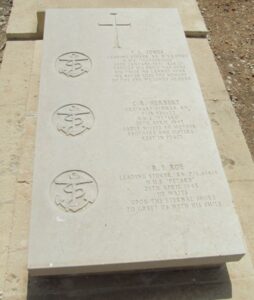
Albert Gordon Laugharne, B.A., Sub-Lieutenant, Royal Naval Volunteer Reserve. Albert was born on 11 January 1917, the son of Albert Henry Laugharne and Rose Laugharne (nee Hand), of 1, Pantyllyn Terrace, Llandeilo. After gaining his BA, he became a policeman prior to the war and married Rosamond Mair Hicks at Ammanford on 29 August 1942. Albert then gained a commission as Temporary Sub-Lieutenant into the Royal Naval Volunteer Reserve and was posted aboard HMS Blackwood, an American Lend-Lease Destroyer that had been taken over by the Royal Navy on 27 March 1943. After over a year spent carrying out escort duties with the Atlantic convoys Blackwood was torpedoed by U-764 off Portland Bill on 15 June 1944, and sank the next day under tow. Albert was 27 years old when he was killed in the initial torpedo strike. He has no known grave, so is commemorated on the Plymouth Naval Memorial.
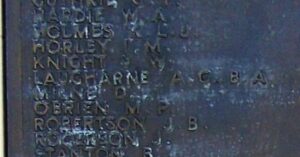
James John Lewis, Leading Aircraftman (Air Gunner), 1027992, Royal Air Force Volunteer Reserve. James was born on 24 December 1915, the son of Jack Lewis and Elizabeth Gertrude Lewis (nee Phillips), of 21, Talbot Road, Ammanford. He married Gertrude Thomas, of Albania House, Brynamman at All Saints Church, Betws on 16 April 1938. James worked as a collier prior to enlisting into the Royal Air Force Volunteer Reserve and after basic training was posted to No 8 Air Gunnery School in Scotland, on an Air Gunnery course. On 6 October he was flying in a Blackburn Botha, serial L6435, on a training flight in low cloud, when it crashed into high ground near Alness, Ross and Cromarty, Scotland, killing all of her crew. James was 25 years old when he died that day and was brought home for burial in St. Catherine’s Churchyard, Upper Brynamman.
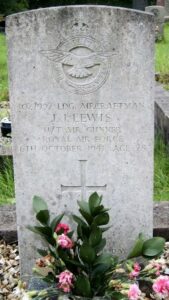
Howard Glyn Mainwaring, Private, 13114537, Pioneer Corps. Howard was born on 8 September 1902, the son of John Mainwaring and Jane Mainwaring (nee James), of 7, Ynysderw Road, Pontardawe. His mother died soon afterwards and Howell spent much of his childhood with his aunt, Elizabeth Howells, at Ammanford. He worked as a painter prior to the war and upon enlisting into the army was posted to the Pioneer Corps. Very little else is known of Howell’s war, but he died on active service in the Carmarthen registration district on 13 November 1942. The remains of the 40-year-old were buried in Saron Congregational Old Chapelyard, Rhydfro, just north of Pontardawe. Howell is not commemorated on the Ammanford War Memorial.
Edward John Mason, Corporal, 3955706, Welch Regiment. Edward was born on 18 June 1906, the son of James Mason and Rose Hannah Mason (nee Hopkins), of Ammanford. He married Blodwen Ann Lewis at Ammanford in 1925 and the couple set up home at 53, Pantyffynon Road, Ammanford. Edward was a Territorial Army reservist and had served with the 4th Battalion, Welch Regiment, for several years before the war. He was mobilised with the battalion soon after the outbreak of War. The 4th Welch was attached to the 160th Infantry Brigade, 53rd (Welsh) Division and moved to positions around Pembroke Dock initially, before moving to Northern Ireland in April 1940. Edward sadly never made the move to Northern Ireland as by now his health had broken down and he died at home of pneumonia on 28 May 1940. The 33-year-old was buried in Ammanford Cemetery. Many thanks to Terry Norman for the photograph of the grave and to Edward’s Granddaughter for the photograph of Edward. He is not commemorated on the Ammanford War Memorial.
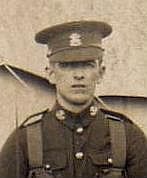
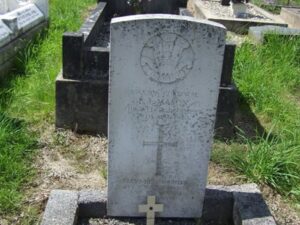
Arthur Charles Morgan, Sergeant (Observer), 563340, Royal Air Force. Arthur was born in 1912, the son of Edwin William Morgan and Margaret Ellen Morgan (nee Rainford), of 6, Union Street, Ammanford. He enlisted into the Royal Air Force prior to the war and after completing his training as an Observer was posted to 105 Squadron, Royal Air Force, which was equipped with the Fairey Battle, a single-engined light bomber. In September 1939 the squadron moved to France, initially on reconnaissance missions along the France-German border, but following the German invasion of France in May 1940 the squadron began attacking the advancing German troops. One of the most important targets was the bombing of the bridges over the River Meuse in attempt to slow down the German advance. On 14 May 1940, Arthur was flying aboard a Fairey Battle, Serial L5238, on one such mission, attacking bridges near Sedan, when his aircraft was brought down, crashing near Noyers-Pont-Maugis. The 28-year-old was buried besides his pilot, Richard Nap, and their Air Gunner, Harold Hatton, in Noyers-Pont-Maugis French National Cemetery.
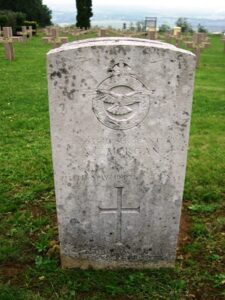
Dennis Edwards Morgan, Corporal, 2216911, Royal Air Force Volunteer Reserve. Dennis was born in 1924, the son of David Edgar Morgan and Eva Morgan (nee Edwards), of 100, James Street, Llanelli. His father was a Police Sergeant and some years prior to the war had moved the family to 19, Llandybie Road, Ammanford. Dennis enlisted into the Royal Air Force Volunteer Reserve and was posted to the Far East with the Royal Air Force Police. Following the surrender of the Japanese he became posted to RAF Penang, in Malaya. On 29 June 1946 Dennis was aboard an RAF Dakota IV transport plane, Serial KJ918, of 48 Squadron which was lost at sea off Malaya when returning to RAF Changi in bad weather, killing ten members of the RAF Police. Dennis was 22 years old, and is commemorated on the Singapore Memorial, Singapore. He is not commemorated on the Ammanford War Memorial.
Jestyn Morgan, DSM, Leading Seaman, C/JX 137898, Royal Navy. Jestyn was born on 4 May 1917, the son of Jestyn Morgan and Patience Mary Morgan (nee Kennedy), of Ammanford. His father died in 1928 and Jestyn and his mother moved to 82, Hornchurch Road, Romford. Jestyn enlisted into the Royal Navy in 1939 and upon completing his training was posted aboard the Flower-class corvette, HMS Marigold, which had been launched on 4 September 1940 specifically for convoy escort duties. Marigold had a very busy start to her Naval career over the coming months, participating in several Atlantic and Mediterranean Convoys, sinking the German U-Boat U-433 on 16 November 1941 and playing a vital role in driving off the attacks of several other U-Boats on subsequent convoys. Jestyn was obviously a very able sailor, as he was awarded the Distinguished Service Medal in January 1942 ‘For skill and enterprise in action against enemy submarines.’ On 9 December 1942, Marigold was escorting convoy MKS 3Y, off Algiers, Algeria when she came under attack by three Italian torpedo bombers and was hit by a single torpedo, before sinking with the loss of 40 lives. Jestyn was 25 years old when he died that day. He has no known grave but the sea, so iis commemorated on the Chatham Naval Memorial, Kent. Jestyn is not commemorated on the Ammanford War Memorial.
Jonathan Raymond Morgan, Assistant Steward, 122228, Naval Auxiliary Personnel (Merchant Navy). Jonathan was born in 1914, the son of William Morgan and Sarah Jane Morgan (nee Edwards), of 2, Iscennen Road, Ammanford. He enlisted into the Merchant Navy and was posted to the Naval Auxiliary Personnel, before joining the crew of HMS Rawalpindi, a former P&O cruise liner which had been requisitioned by the Admiralty and converted into an armed merchant cruiser by the addition of eight 6-inch guns and two 3-inch guns, before being sent on patrol in the area around Iceland. While patrolling north of the Faroe Islands on 23 November 1939, she investigated a possible enemy sighting, only to find that she had encountered two of the most powerful German warships, the battlecruisers Scharnhorst and Gneisenau, trying to break out into the Atlantic. The Rawalpindi was able to signal the German ships’ location back to base, then despite being hopelessly outgunned, Captain EC Kennedy of the Rawalpindi decided to fight, rather than surrender as demanded by the Germans. The German warships returned fire and sank Rawalpindi within forty minutes. Jonathan was 25 years old when he was killed in the sinking of Rawalpindi that day. He has no known grave, so is commemorated on the Liverpool Naval Memorial.
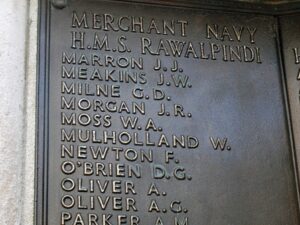
William Lincoln Morgan, Private, 14473327, Welch Regiment. William was born on 11 February 1928, the son of William Morgan and Elizabeth Morgan (nee Mainwaring), of 2, Talbot Road, Ammanford. He enlisted into the army after World War 2 and served with the 1st Battalion, Welch Regiment. In November 1951 the 1st Welch disembarked at Pusan, Korea as part of the 29th British Infantry Brigade, 1st Commonwealth Division. The Welch took over a section which had been held at great cost by the 1st Gloucesters, then spent a hard winter patrolling the frontier of South Korea, under constant shelling and mortar fire. William was wounded in Korea, and died on 15 February 1952, aged 24. He is buried in Yokohama British Commonwealth Cemetery, Japan. The photographs of William and his grave are courtesy of Meinir Davies.
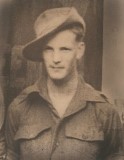
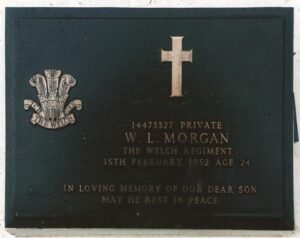
David William Richard Phillips, Able Seaman, Merchant Navy. David was born on 3 September 1920, the son of Blodwen Phillips, of 29, Iscennen Road, Ammanford. He enlisted into the Merchant Navy and was posted aboard the cargo steamer SS Baron Carnegie. Cargo ship Baron Carnegie had left Swansea in ballast for Milford Haven then joined up with the Halifax bound 51 ship Convoy OB-334, which left Liverpool on 11 June 1941. The ship was to depart the convoy at a later date and position in the Atlantic and head for the African port of Takoradi. Unfortunately, the very same day the ship was attacked and damaged by German aircraft West of St. Davids Head in the Bristol Channel, killing 25 crew. The ship was taken in tow by the tug SS Seine but sank at 11.30pm on 11 June 1941. David was one of the men killed aboard her that day, and his body was among seven recovered and brought ashore by the St. Davids lifeboat before being conveyed home for burial in Ammanford Cemetery. He was just 20 years old.
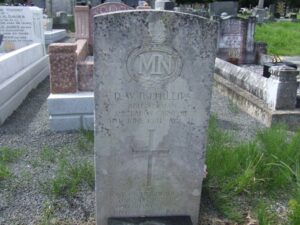
Randolph Prince, Corporal, 7631687, Queen’s Own Royal West Kent Regiment. Randolph was the son of Edwin Prince and Edith Prince (nee Roberts), of 3, St. Albans Road, Wrexham. He married Rachel Eunice Williams, of Ammanford, in 1939. Randolph worked as a colliery labourer at Ammanford prior to enlisting into the army and was posted to the 4th Battalion, Queen’s Own Royal West Kent Regiment. The battalion had been in France with the BEF at the outbreak of war and had been evacuated from Dunkirk. On 31 May 1942 the Battalion embarked at Liverpool for Egypt, where it joined the 44th Division and fought at the Battle of El Alamein, before moving to Burma, becoming attached to the 161st Indian Brigade, 5th Indian Division, before moving to Kohima. Unfortunately, Kohima soon came under siege by the Japanese 15th and 31st Divisions and remained cut off for 14 days from 5 April to 19 April 1944. During this time a great deal of very nasty close quarters fighting took place, and at the end of 14 days of continuous fighting with little food, water, or sleep the survivors were in bad shape but victorious. RWK casualties were 199 wounded with 61 dead. Their Lance corporal John Harmen was posthumously awarded the Victoria Cross for his single handed charge into a Japanese bunker, killing all 5 Japanese soldiers who had had his company pinned down. Randolph was wounded on 22 February 1944, but returned to duty in time to take part in the bloody Battle of Kohima, where he was wounded again. He sadly died of his wounds on 16 April 1944, aged 30. Randolph is buried in Ranchi War Cemetery. Randolph is not named on the Ammanford Memorial.
Howell John Rees, Private, 6026955, Cambridgeshire Regiment. Howell was born on 29 March 1915, the son of Edward John Rees and Elizabeth Rees (nee Morgan), of Tyn-y-Cwm, Betws. The family later resided at 44, Llwyn Road, Cwmgorse. He worked as a coal hewer prior to enlisting into the army and was posted to the 2nd Battalion, Cambridgeshire Regiment. The battalion was sent to Singapore in early 1942 and reinforced the 15th Indian Brigade at Batu Pahat. Singapore was the foremost British military base and economic port in South–East Asia and was known as the ‘Gibraltar of the East’. It was strongly garrisoned and was thought to be impregnable. On 8 December 1941 the Japanese launched a series of simultaneous attacks against Pearl Harbour, Malaya, Thailand and the Pacific Islands. The Japanese had a force of some 30,000 troops involved in the Malayan invasion but soon reached the outer defences of Singapore following a short period of intense fighting. General Percival, commanding a garrison of some 85,000 troops in Singapore was ordered by Winston Churchill to fight to the last man, however, on 15 February 1942 he surrendered, and 80,000 troops were marched into captivity. Howell was marched into captivity, together with the survivors of his battalion, and was incarcerated at Changi Jail. He was later sent to a POW Camp in Thailand, to work on the Thai-Burma Railway. Howell survived the war, but was very ill upon his release and died in Burma on 15 September 1945. The 30-year-old was buried in Rangoon War Cemetery, Myanmar.
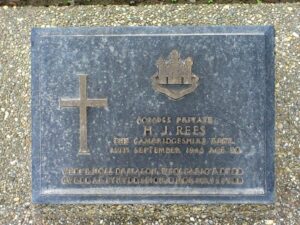
Gilbert Richards, Able Seaman, Merchant Navy. Gilbert was born in 1920, the son of William John Richards and Mary Ellen Richards (nee Houghagin), of 43, Harold Street, Ammanford. He left home prior to the war to join the Merchant Navy and married Gladys O’Leary, of 53, Western Road, Ealing, in 1941. Gilbert was by then serving aboard the Liverpool registered MV Henry Stanley, a cargo motor ship which had been built in 1929 for the African Steamship Company Ltd, a subsidiary of Elder, Dempster & Company Ltd, which later was reorganised as Elder Dempster Lines. Henry Stanley was then put to work carrying general cargo to West Africa and West African produce to Liverpool, continuing on this route after the outbreak of war. At the end of November 1942 Henry Stanley left Liverpool carrying a dozen passengers, some 4,000 tons of general cargo, plus a small amount of gelignite., initially joining Convoy ON 149, which was bound for New York. On 5 December, when the convoy dispersed, Henry Stanley set course unescorted for Freetown. On the night of 6/7 December 1942 the German submarine U-103 torpedoed Henry Stanley, hitting her starboard side and the ship was forced to stop. Her passengers and crew were embarked in her four lifeboats, which were launched and stood off at a safe distance from the ship, then U-103 hit Henry Stanley with a second torpedo, which exploded, detonating the gelignite in the cargo and sinking Henry Stanley some 670 miles west of the Azores. By now a gale had blown up, so the German submarine dived to escape the waves, taking aboard as prisoner Captain Jones of the Henry Stanley, and leaving the four lifeboats to fend for themselves. No-one else survived the tragedy, as the lifeboats were lost in the gale. Gilbert was 22 years old when he was tragically lost in the incident. He has no known grave, so is commemorated on the Tower Hill Memorial, London. Gilbert is not commemorated on the Ammanford War Memorial.
John Wreford Roberts, Ordinary Seaman, D/JX 284771, Royal Navy. John was born at Mountain Ash on 3 July 1909, the son of John Lewis Roberts and Mary Ann Roberts (nee Williams). The family later moved to 43, Iscennen Road, Ammanford. John worked as a colliery labourer prior to enlisting into the Royal Navy, and after completing his training was posted to HMS Eaglet, the Royal Naval Shore Establishment at Liverpool, and the flagship of Commander-in-Chief Western Approaches. John accidentally drowned at the North West Canning Dock at Liverpool on 25 October 1944. The 34-year-old was buried in Liverpool (Anfield) Cemetery. His name is engraved into the Screen Wall, Panel 6. John is not commemorated on the Ammanford War Memorial.
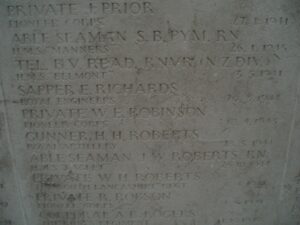
David William Sinnett, Corporal, 3960653, The Kings (Liverpool) Regiment. David was the son of Frederick William Sinnett and Emily Gwendoline Sinnett (nee Banner), of 7, Station Road, Pantyffynnon. He enlisted into the army and was posted to the 13th Battalion, King’s Liverpool Regiment. The Battalion formed in June 1940 and was sent to India, then Burma, where it became part of the Chindits, led by Brigadier Orde Wingate in 1942. The Chindits fought an arduous campaign in the Burmese jungles, where they struck fear among the Japanese following the launching of the first Chindit offensive, Operation Longcloth, on 8 February 1943, when the Chindits, lead by Wingate, began their march into Burma, crossing the Chindwin River on 13 February and faced the first Japanese troops two days later. David was among a large number of men from his battalion posted as missing in Burma during Operation Longcloth, and he was later found to have died as a prisoner of war of the Japanese on 29 July 1943. The 30-year-old was buried in Rangoon War Cemetery, Myanmar and his grave is marked by a Special Memorial there, as the exact location is unknown.
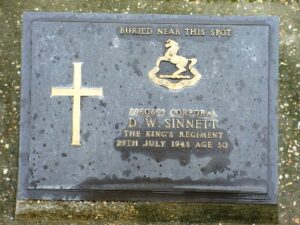
Daniel Owen Thomas, Flying Officer, 124699, Royal Air Force Volunteer Reserve. Daniel was born on 27 October 1917, the son of William Henry Thomas and Ruth Thomas (nee Davies), of Tyrhos, Fferws Hill, Ammanford. He was studying Theology at St. David’s College, Lampeter when war broke out, then enlisted into the Royal Air Force Volunteer Reserve and after completing his training as an Air Bomber was posted to 83 Squadron, Royal Air Force, which was a heavy bomber squadron, based at RAF Wyton, in Huntingdonshire. The squadron was an elite unit, which had been selected to become part of the RAF Pathfinder Force, marking targets for the remainder of the bomber force to strike. The Squadron then took part in missions over Northern Italy, the Ruhr Valley, and started bombing targets in Hamburg during the first few months of 1943. On the night of 11 June 1943, Daniel took off from RAF Wyton aboard an Avro Lancaster I, Serial R5686, piloted by Squadron Leader James Eric Swift, DFC, as part of a raid on the city of Munster. The aircraft had successfully dropped its target indicators on Munster and was making its way home across the North Sea early in the morning of 12 June 1943, when it was shot down about 25 Miles West of Alkmaar, crashing into the sea with the loss of her entire crew of seven. The bodies of Swift and another crewman, sergeant J. J. Anderton, were later washed ashore and buried in Bergen. Daniel’s body was not recovered. The 26-year-old has no known grave, so is commemorated on the Runnymede Memorial. Daniel is not commemorated on the Ammanford War Memorial.
Ieuan Thomas, Fireman, Merchant Navy. Ieuan was born in Merthyr Tydfil in 1920, the son of William Thomas and Sarah Jane Thomas (nee Davies). The family came to live at Ammanford soon afterwards. Ieuan enlisted into the Merchant Navy and was posted as a Fireman aboard the London registered steamer SS Empire Wagtail. Empire Wagtail was built in 1919, as American Ossining for the US Shipping Board, Tacoma. In 1933 she was renamed Point Lobos for the Gulf Pacific Mail Line, San Francisco, and in 1941 given to Britain, and renamed Empire Wagtail by the Ministry of War Transport. In December 1945, Empire Wagtail left Cardiff laden with a cargo of coal and joined up with Convoy ONS 154, bound for Halifax, Nova Scotia. The Convoy had left Britain on 19 December and comprised of 45 Merchant ships, escorted by five corvettes of the Royal Canadian Navy, a rescue ship, and a refuelling tanker. On 28 December 1942, when about 900 miles west of Cape Finisterre, Empire Wagtail was torpedoed by the German submarine U-260 and sank with the loss of her master, 31 crew members and seven DEMS gunners. Ieuan was 22 years old when he was killed during the loss of Empire Wagtail. He has no known grave but the sea, so s commemorated on the Tower Hill Memorial, London.
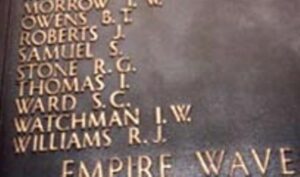
John Godfrey Thomas, Second Mate, Merchant Navy. John was born in 1913, the son of John Thomas and Sarah Thomas (nee Edwards), of Castellduu, Heolddu, Ammanford. He married Mary Kate Davies at Swansea in 1940 and the couple made their home at Penpany, Tycroes, Ammanford. John had enlisted into the Merchant Navy while a young man and by the time of his marriage was serving as Second Mate aboard the Bideford registered MV Cornish City, a Collier which was owned by the Reardon Smith Line of Cardiff. In February 1941 John took ill whilst Cornish City was at sea and he died of suspected typhoid on 17 February 1941, aged 27. He died of natural causes, so is not commemorated as an official war casualty. Cornish City was later sunk by the German submarine U-177 on 29 July 1943, going down with the loss of 27 lives.
Stanley Thomas, Sergeant, 1836816, Royal Air Force Volunteer Reserve. Stanley was born in 1922, the son of John Griffith Thomas and Lizzie Mary Thomas (nee Morgans), of Arfania, Penybank, Ammanford. He enlisted into the Royal Air Force Volunteer Reserve and after completing his training as an Air Gunner was posted to 298 Squadron, Royal Air Force, which was a Special Operations Squadron, formed on 4 November 1943 at RAF Tarrant Rushton, in Dorset, equipped with the Handley Page Halifax heavy bomber. The squadron also trained in towing Horsa and Hamilcar gliders and on D-Day, 6 June 1944, towed the Horsa Gliders which landed on Pegasus Bridge, carrying the 6th Airborne Brigade. The squadron then resumed its Special Operations work, continuing on re-supply drops throughout the remainder of the war, and also towed Gliders to Arnhem, as part of Operation Market Garden. Stanley was killed when his Handley Page Halifax AVII, Serial NA347, was shot down at Alphen, southwest of Amsterdam, on Operation Medico 6, a drop to supply SOE Agents at Stompwijk, Holland, on 13 April 1945. He was 22 years old, and is buried at Amsterdam New Eastern Cemetery, Holland.
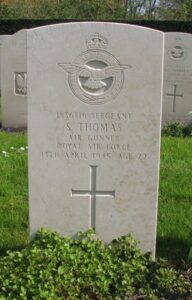
Thomas Elwyn Thomas, Driver, T/172890, Royal Army Service Corps. Thomas was born on 25 December 1919, the son of Thomas Albert Thomas and Jennie Thomas (nee Jones), of 112, Margaret Street, Ammanford. He worked as a motor lorry and driver and fitter prior to enlisting into the army, and with his skills was posted to 164 General Transport Company, Royal Army Service Corps. Thomas was stationed in North Africa when Rommel’s Afrika Korps landed at Libya to reinforce the failing Italian Army. Thomas was killed on 21 March 1941. The 21-year-old has no known grave, so is commemorated on the Alamein Memorial, Egypt.
William Rheinallt Thomas, Private, 7618185, Royal Army Ordnance Corps. William was born on 30 September 1917, the son of William Sydney Thomas and Hannah Maria Thomas (nee Hughes), of Castellbach, 39, High Street, Ammanford. He had just finished training as a teacher when war broke out and upon enlisting into the army was posted to the 1st Advance Ordnance Workshop, Royal Army Ordnance Corps. Very little is presently known of William, but he probably served in France with the BEF. He died at sea on 10 September 1940, aged just 22, and is commemorated on the Brookwood Memorial, Surrey.
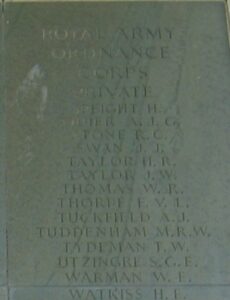
Henry Vaughan, Air Raid Warden, Air Raid Precaution. Henry was born at Llanedy on 6 July 1888, the son of William Vaughan and Rachel Vaughan (nee Davies). His parents later moved to Hazeldene, 49, Walter’s Road, Ammanford. Henry married Gwenllian Walters in 1909 and the couple settled at Trewen, Blaenau, Llandybie. He worked as a colliery fireman and underground examiner for many years prior to the war, and was a member of the St. John’s Ambulance Brigade. When war broke out Henry volunteered to serve as an Air Raid Warden with the Air Raid Precaution (ARP) and was based at Swansea. Henry had survived the terrible carnage that Swansea suffered during the Blitz, but was probably injured during a small scale air raid upon the city on the night of 13/14 February when a single German aircraft dropped a bomb which exploded at Ysgol Street, St. Thomas. Henry died at Swansea Hospital on 16 February 1943, aged 54. He is not commemorated on the Ammanford War Memorial.
David John Walters, Sergeant, 1452964, Royal Air Force Volunteer Reserve. David was born in 1922, the son of Owen Pugh Walters and Mary Jane Walters (nee Jones), of Saron, Ammanford. He enlisted into the Royal Air Force Volunteer Reserve and after completing his initial training was posted to 1675 Heavy Conversion Unit, which was based at RAF Abu Suier, in Egypt, which was a three week long course for training on the Consolidated B-24 Liberator heavy bomber. On 19 January 1945, David took off from Abu Suier aboard a Consolidated Liberator B.VI, Serial EV854, on a navigational exercise. David, together with the remainder of his crew, were posted as missing, believed killed when their Liberator failed to return to base later that day. The 23-year-old has no known grave and is commemorated on the Alamein Memorial, Egypt.
Edward Leslie Widgery, Sergeant (Flight Engineer), 1379326, Royal Air Force. Edward was born at Sketty on 30 October 1907, the son of Albert William Widgery and Ann Elizabeth Widgery (nee Webber). His parents later resided at Ammanford. Edward married Iris Mary Ellesmere Jones at Swansea in 1938, and the couple settled at 9, Wimmerfield Drive, Sketty, Swansea. He worked as a dealer of household goods prior to enlisting into the Royal Air Force and after completing his training as a Flight Engineer was posted to 102 Squadron, Royal Air Force, which was an RAF Bomber Command unit, originally based at RAF Linton-on-Ouse, equipped with the Armstrong Whitworth Whitley. A move to RAF Topcliffe in November 1940 saw the squadron settled for a year until it moved to nearby RAF Dalton, where it began to receive Handley Page Halifax bombers in December 1941 with the last Whitley operation being flown on 31 January 1942. A brief return to Topcliffe in June 1942 was followed by a move to RAF Pocklington, in Yorkshire, on 7 August of that year. Conversion continued at Pocklington with the first operation taking place on 14 April 1942. On the night of 25 February 1943, Edward took off from RAF Pocklington aboard Handley Page Halifax II, Serial DT800, which joined a bomber group despatched to strike the German city of Nuremberg. The weather was atrocious, and the Halifax went out of control soon after take-off, crashing near Ardleigh, some four miles Northeast of Colchester, Essex, exploding on impact. Edward and his six fellow crewmen were killed upon impact. The remains of the 35-year-old were recovered from the wreck, and he was brought home for burial in Oystermouth Cemetery, Swansea. Edward is not commemorated on the Ammanford War Memorial.
Ernest John Williams, Private, 6144769, East Surrey Regiment. Ernest was born in 1918, the son of Jonah Williams and Ellen Williams (nee Davies), of 31, Bettws Road, Bettws. He enlisted into the army and was posted to the 1st Battalion, East Surrey Regiment. The battalion had been in France with the BEF when war broke out, as part of the 11th Infantry Brigade, 4th Division, and was evacuated from Dunkirk in May 1940. Upon its return to Britain the battalion was reformed and the 11th Infantry Brigade became part of the 78th Infantry Division, which it remained with for the rest of the war. The division spent the coming two years on home defence duties before being despatched to the Middle East to participate in Operation Torch in November 1942, the Allied landings at Algiers, as part of the First Army. The division then took part in the remainder of the Tunisian Campaign, where it gained a formidable reputation as a fine fighting force. Ernest was originally posted as wounded and missing in Tunisia on 2 December 1942, somewhere east of Medjez-el-Bab, during a counter-attack by the German 10th Panzer Division, but was later deemed to have died of wounds on that date. The 22-year-old has no known grave, so is commemorated on the Medjez-El-Bab Memorial, Tunisia.
John Lynn Williams, Aircraftman 2nd Class, 1077842, Royal Air Force Volunteer Reserve. John was born on 16 March 1919, the son of William Williams and Gwladys Williams (nee Mathias), of 30, Bishop Road, Ammanford. He worked as an Ironmonger’s Assistant prior to enlisting into the Royal Air Force Volunteer Reserve and was posted out to the Far East to join the 153rd Maintenance Unit, Royal Air Force, which had formed at Kuala Lumpur, Malaya, in June 1941. On 7 December 1941, in conjunction with their attack on Pearl Harbour, Japanese forces launched attacks across the Pacific, most notably in Malaya. The culmination of this massive offensive, for the British, was when the strategically important fortress island of Singapore was surrendered to the Japanese on 15 February 1942. Other garrisons around the Pacific surrendered around this time and many thousands of men were marched into captivity. John was captured at Tasik Malaja, Java on 8 March 1942, following the Japanese invasion of Malaya, and was given the POW No. 2976. John survived three years as a prisoner of war in Borneo, but unfortunately became one of the victims of the 1st Sandakan death march (formed of nine groups leaving Sandakan for Ranau, Borneo between 29 January and 6 February 1945), when he became ill and died of acute enteritis at Ranau, North Borneo on 17 March 1945. The 26-year-old was buried in Paginatan Cemetery, although he is today commemorated on the Singapore Memorial, Singapore.
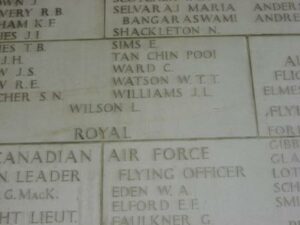
Thomas John Irlwyn Williams, Sapper, 2147820 Royal Engineers. Thomas was born in 1921, the son of David James Williams and Margaret Anne Williams (nee Childs), of Ammanford. Thomas enlisted into the army and was posted to the 210th Field Company, Royal Engineers. The company was attached to the 44th (Home Counties) Infantry Division and was mobilised at the outbreak of war, embarking for France to join the BEF and took part in the Battle of St Omer-La Bassée during the retreat to Dunkirk, from where it was evacuated at the end of May 1940. The division then spent two years on home defence, rebuilding, before embarking for North Africa on 29 May 1942 where it joined the Eighth Army at El Alamein and took part in the Battle of Alam el Halfa. The division then took part in the Second Battle of El Alamein from 23 October until 4 November 1942 and was employed with tying down Axis reserves while the main thrust was made in the north by XXX and X Corps. Thomas was posted as missing, believed killed, just after the battle, on 14 November 1942. The 21-year-old was originally buried on the battlefield in a small cemetery, but the following year the graves within the cemetery were exhumed and re-interred in El Alamein War Cemetery, Egypt.
Thomas Norman Williams, Stoker 1st Class, D/KX 132385, Royal Navy. Thomas was born on 16 November 1906, the son of Stephen John Williams and Margaret Rebecca Williams (nee Thomas), of Ty Uchaf, Ammanford. He worked as an underground collier rider prior to enlisting into the Royal Navy and upon completing his training was posted aboard the Hunt Class destroyer HMS Hurworth, which had been commissioned in October 1941. Hurworth saw action in the Atlantic after going into service and then moved to the Mediterranean. She was operating in the Aegean on 22 October 1943 when she struck a mine and sank with the loss of 113 lives. Thomas was 36 years old when he died in the sinking of Hurworth that day. He has no known grave, so is commemorated on the Plymouth Naval Memorial, Devon.
William Rees Williams, Chief Steward, D/LX21365, Royal Navy. William was born on 12 March 1911, the son of David Williams and Margaret Jane Williams (nee Davies), of 19, Norman Road, Tirydail, Ammanford. He married Susanna Rebecca James in 1938. William enlisted into the Royal Navy and upon completing his training was posted aboard the Tribal-class destroyer, HMS Punjabi. She had been commissioned in 1939 and was immediately put to work patrolling the North Atlantic with the rest of the 6th Destroyer Flotilla. Punjabi took part in the Norwegian Campaign and was badly damaged during the Second Battle of Narvik on 13 April 1940. She was soon repaired and back on duty. The following year she took part in the hunt for the German battleship Bismarck, but missed the final destruction of the mighty ship as she was forced to return to Hvalfiord, Iceland to refuel. She then began taking part in Arctic Convoy escort duties, until returning to Britain for a refit in January 1942, returning to her Home Fleet duties upon completion and soon afterwards took part in an abortive hunt for the German battleship Tirpitz. Punjabi was on duty with convoy PQ-15 on 1 May 1942, when the battleship HMS King George V crashed into her port side, in poor visibility, slicing Punjabi in half, causing her stern to sink quickly and set off a number of her depth charges. William was tragically among 49 crewmen killed aboard Punjabi during the incident. The 31-year-old has no known grave, so is commemorated on the Plymouth Naval Memorial, Devon.
